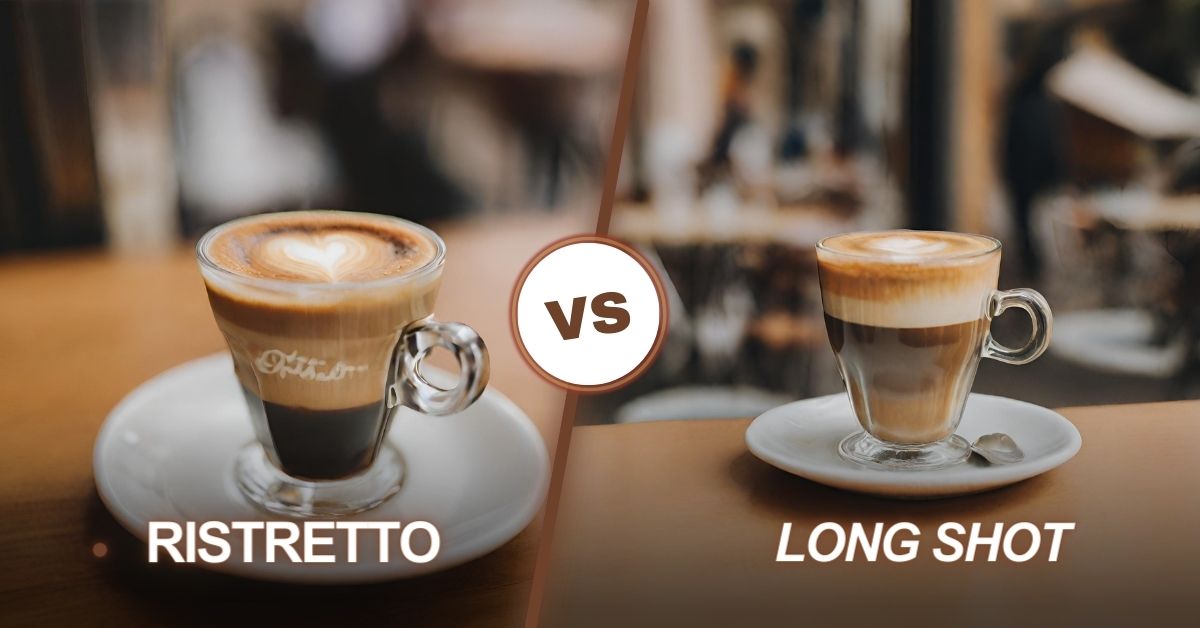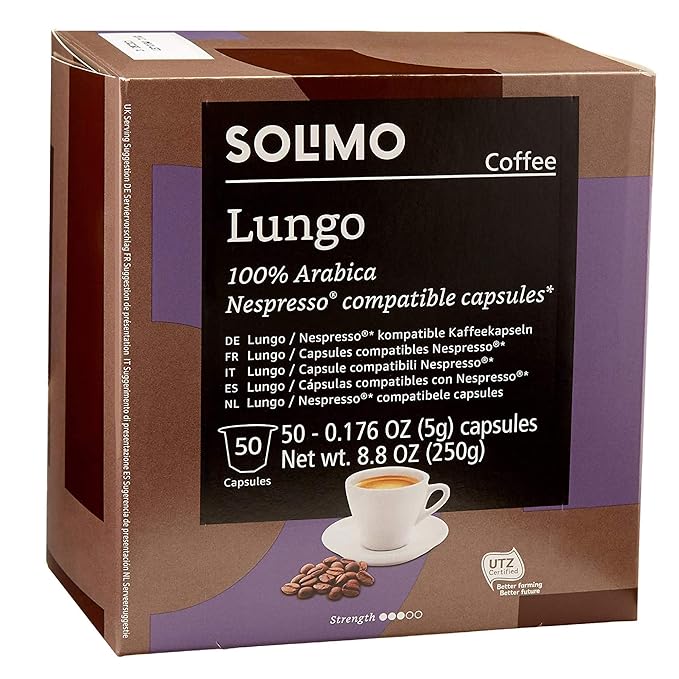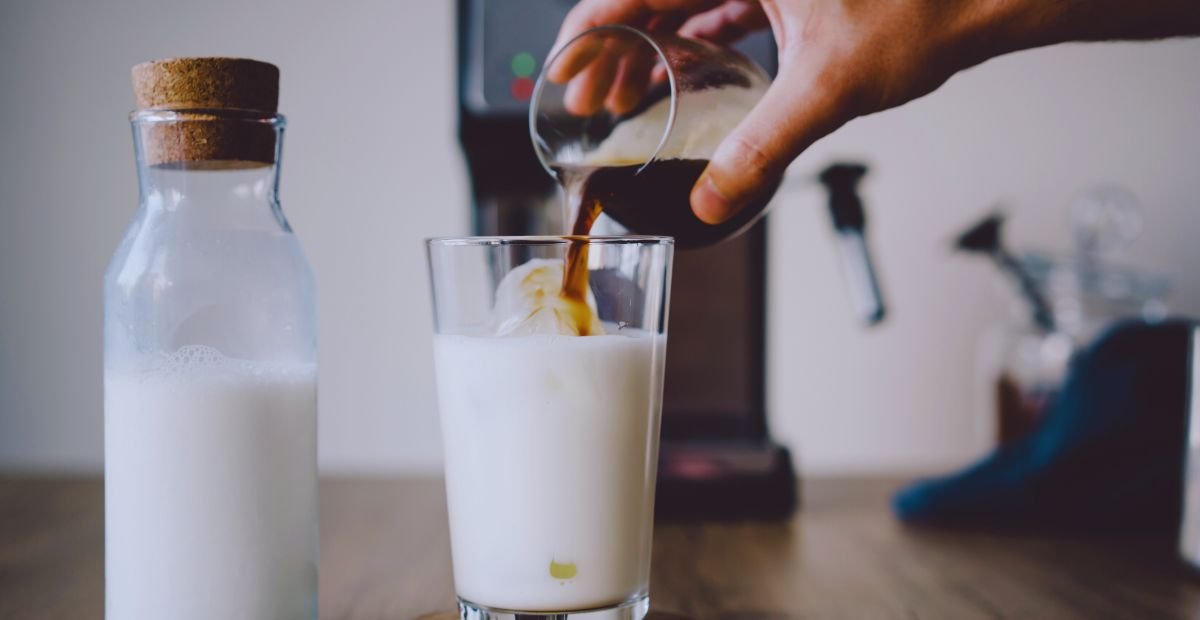Ristretto vs Long Shot: What’s the difference?

In the category of espresso, two distinct experiences await the discerning palate: the ristretto vs long shot. A ristretto embodies intensity in its concentrated form.
It offers a small yet potent shot, bursting with flavor and depth. This miniature marvel is crafted through a brief extraction process, capturing the essence of the coffee bean with minimal bitterness.
On the other end of the spectrum lies the long shot, a journey of extended extraction resulting in a larger volume of espresso. While less intense than its ristretto counterpart, the long shot presents a smoother. It has a more approachable profile, inviting a leisurely exploration of coffee’s nuanced flavors.
Whether one seeks the bold punch of a ristretto or the relaxed elegance of a long shot, The choice between the two offers a quick look into the diverse world of espresso appreciation, where every sip is a discovery.
What is a ristretto?
It is a strong, concentrated shot of espresso coffee made with a finer grind and less water than a typical espresso shot. The word “ristretto” is an Italian word that means “restricted”, which refers to the limited amount of water used in the brewing process.

Features:
Size:
A ristretto is a small shot, typically around 20 ml (0.7 fl oz), which is about half the size of a regular espresso.
Strength:
Despite its size, it packs a powerful punch due to the concentrated coffee grounds and shorter extraction time.
Flavor profile:
- Ristretto is known for its sweeter, richer taste with less bitterness compared to espresso.
- This is because the shorter extraction avoids extracting the harsher flavor compounds from the coffee grounds.
Comparison to lungo:
The opposite of a ristretto is a lungo, which means “long” in Italian. Compared to a regular espresso, a lungo is made with extra water, making it a bigger, less concentrated coffee beverage.
Uses:
- It can be enjoyed independently for a quick and intense coffee experience.
- It’s also used as a base for some espresso-based drinks where its sweetness and richness can enhance the flavor, such as certain lattes and flat whites.
How it’s made:
- Similar to espresso, hot water is forced through finely ground coffee.
- But for the ristretto, the barista uses half the amount of water and stops the extraction earlier, around 15-20 seconds.
- It is compared to 25-30 seconds for espresso.
What is a Long shot?
The name “long shot” refers to a longer espresso shot that is effectively produced. It’s known as Lungo to the Italians. You could think of it as Ristretto’s exact opposite
A shot of espresso that is not as concentrated is used to brew it. More water has been added to the coffee during preparation than in a regular espresso shot.

Features :
Size:
- A long shot yields a significantly larger volume of espresso compared to a standard shot.
- Typically, a long shot is around 2-3 ounces, while a standard shot is 1-1.5 ounces.
Strength:
- Due to the increased water used in extraction, long shots are less concentrated than standard espresso.
- This translates to a lower amount of coffee solids per ounce of liquid.
Flavor Profile:
- The longer extraction with more water results in a less intense and smoother flavor compared to a standard shot.
- Long shots tend to have lower acidity than standard shots, which some people prefer.
Use:
- The larger volume and smoother taste make long shots a good base for milk-based espresso drinks like lattes and cappuccinos.
- The extra volume allows for a more balanced coffee-to-milk ratio without overwhelming the milk with a strong espresso flavor.
How It’s Made:
- Grind your espresso beans a touch coarser than for a standard shot.
- This allows for better water flow through the grounds during the longer extraction.
- Fill the portafilter basket with ground coffee (around 7-8 grams) and tamp evenly for a compressed puck.
- Ensure your espresso machine is preheated and flushed with a little water to clear any residue.
- Place the portafilter and lock it in.
- Start the extraction, aiming for a longer duration (30-60 seconds) compared to a standard shot.
- The ideal yield is 2-3 ounces of espresso.
- You can use a scale or rely on visual cues to stop the extraction at the desired volume.
- Serve your long shot immediately in a preheated cup or use it as a base for milk-based coffee drinks.
Comparison between ristretto Vs long shot
| Aspect | Ristretto | Long Shot |
| Definition | A short, concentrated shot of espresso made with the same amount of coffee but half the amount of water. | An espresso shot is made with more water and brewed for a longer duration, resulting in a larger volume. |
| Extraction time | Shorter extraction time, usually around 15-20 seconds. | Longer extraction time, typically around 25-30 seconds. |
| Flavor profile | Intensely flavored, with a sweeter and more concentrated taste due to less water, extracting more oils and solids from the coffee grounds. | to Milder flavor compared to ristretto, with a more diluted taste due to the additional water extracting fewer oils and solids. |
| Crema | Typically, it has a thicker and more intense crema layer due to the shorter extraction time. | It may have a thinner crema layer due to the longer extraction time and additional water. |
| Strength | Stronger in flavor and caffeine content due to the concentrated extraction. | Weaker in flavor and caffeine content compared to ristretto due to the dilution with more water. |
| Volume | Smaller volume, usually around 0.5 to 0.75 ounces (15–22 ml). | Larger volume, typically around 2 to 3 ounces (60–90 ml). |
| Popular uses | People who like their coffee strong but not too bitter tend to favor them. | Commonly used as a base for milk-based espresso drinks like lattes and cappuccinos. |
| Specialty drinks | It is frequently used in specialty coffee shops and by enthusiasts looking to explore the nuances of different coffee beans. | It is often used as the base for iced coffee or in recipes that require a larger volume of espresso. |
Read Also:
FAQs about Ristretto vs Long Shot
Is espresso weaker than ristretto?
it uses a 1:1 brewing ratio, whereas a typical coffee contains an equal proportion of coffee grinds to water. The ratio of coffee grounds to hot water is known as the “brew ratio.” Because of this, a ristretto coffee is thought to be richer and more flavorful than a typical espresso shot, although having half the volume.
Is ristretto or espresso caffeine-free?
Because ristretto is far more concentrated and extremely sweet than regular espresso, it has a stronger flavor profile. A shot of coffee will provide you with greater energy than a small amount of ristretto because of its shorter brewing time, which means it contains less caffeine.
Can milk be added to the ristretto?
Your cappuccino or latte’s steamed milk softens and balances the strong flavors of the coffee it builds upon; a ristretto’s additional sweetness intensifies this effect even more.
Which kind of espresso shot is the strongest?
Ristrettos are the most strong coffee kind; they have the highest caffeine content among other coffee types. A lungo has a greater caffeine content than a ristretto since it is larger.
What is the Ristretto and long-shot espresso ratio?
Commonly known as a limited shot, the ristretto shot usually has a brew ratio of 1:1 to 1:1.5. A lungo or long shot is often about 1:3, whereas a regular espresso is usually 1:2–1:2.5. It’s crucial to keep in mind that those ratios are more like suggestions than strict regulations.
How is the espresso ratio calculated?
The usual ratio of 1:2 corresponds to 1g of caffeine to 2g of liquid, resulting in a 40-gram shot if you select an additional shot and 20 g of coffee. Consider switching to a 1:1.5 ratio, which will result in 30 g of liquid rather than the usual 40 grams, if you would prefer a stronger 20-gram shot.
Wrapping up
In conclusion, ristretto vs long shot espresso shots offer distinct sensory experiences and serve different purposes in the realm of coffee. Ristretto, with its intense flavor and concentrated profile, appeals to aficionados seeking a bold and nuanced coffee experience.
Conversely, long shots provide a milder taste with a larger volume, making them suitable for incorporating into milk-based beverages or enjoying as a refreshing, diluted espresso option.
Whether savoring the richness of a ristretto or embracing the versatility of a long shot, both styles contribute to the diverse landscape of espresso culture, catering to varying preferences and occasions.




